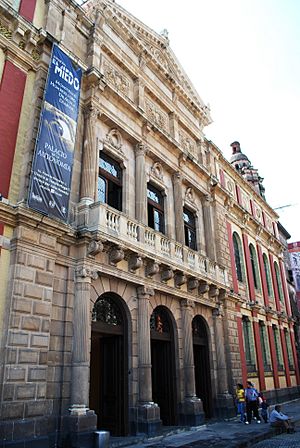Palacio de la Autonomía facts for kids
The Palacio de la Autonomía (which means Autonomy Palace) is a special building in Mexico City. It's now a museum. This place is famous because the Universidad Nacional Autónoma de México (UNAM) became independent here in 1929. This meant the university could make its own decisions without the government telling it what to do.
The building itself is quite old, built in the late 1800s. You can find it on the corner of Licenciado de Verdad and Rep de Guatemala streets. It's near the old Santa Teresa la Antigua church and the ancient Templo Mayor. This spot has a history going back over 500 years! It was even part of the land given out by Hernán Cortés long ago.
The current building was put up when President Porfirio Díaz was in charge. It was given to the university in 1910. Over the years, this building has been used for many things. It was once a dental school and a high school. Today, it is home to the Museo de la Autonomía Universitaria, which means the University Autonomy Museum.
Contents
What the Palace Looks Like
This building was built during the time of President Porfirio Díaz. It now belongs to the Universidad Nacional Autónoma de México. The way it's designed is called "eclectic." This means it mixes different styles.
The palace is made of white stone. This stone was brought all the way from Pachuca. The front of the building has a special triangular top part called a pediment. It has cool designs and leaf shapes carved into it. Part of the building's base even sits on an old wall. This wall used to surround the sacred plaza of the Templo Mayor.
A Long History of the Palace
The land where the palace stands has a history of more than 500 years. After the Spanish took over the Aztec Empire, Hernán Cortés gave out different areas in the Aztec city of Tenochtitlan. This specific spot was set aside for Luis de Rivera. He was the first person in charge of the coin mint in New Spain.
Later, this area became part of the Santa Teresa la Antigua convent. When the convent closed because of the Reform Laws, the building here became homes. The government of Porfirio Díaz then bought this property. They built the current palace in the early 1900s. In 1910, it became the Teachers’ College. This college was part of the National University of Mexico, which is now UNAM.
The University's Home
As part of UNAM, the building first held the dean's offices. In 1929, something very important happened here. Documents were signed that gave the university its independence. This meant the government could no longer directly control what the university taught or how it was run.
After 1930, the building changed uses again. It became the School of University Initiation. Then it was the National School of Commerce and Administration. When most of UNAM moved to the huge Ciudad Universitaria, this building became the National School of Dentistry.
In 1958, the dental school grew too big and moved out. The palace then became the main campus for the School of Nursing and Obstetrics. Finally, it was used as a high school, Plantel Número 2 “Doctor Erasmo Castellanos Quinto.” It stayed a high school until 1978.
The University Autonomy Museum
In the early 2000s, a group of dentists worked hard to fix up the building. Today, it is a museum called the Museo de la Autonomía Universitaria. People also often call it the Palacio de la Autonomía.
The National University of Mexico became independent in 1929. This meant it was free from direct government control over its classes. This independence is super important for public universities in Mexico. To celebrate the 75th anniversary of this event in 2004, the building was given its current name.
The museum has a special Hall of Mexican Dentistry. It also has a space for temporary exhibits. You can see an exhibit about old archaeological finds too. The university's radio station, UNAM-FM, is also located here. The museum keeps old papers and records about the people who helped the university gain its independence. There are even windows built into the floor. These let visitors see parts of the old convent's foundations!
See also
 In Spanish: Palacio de la Autonomía para niños
In Spanish: Palacio de la Autonomía para niños


